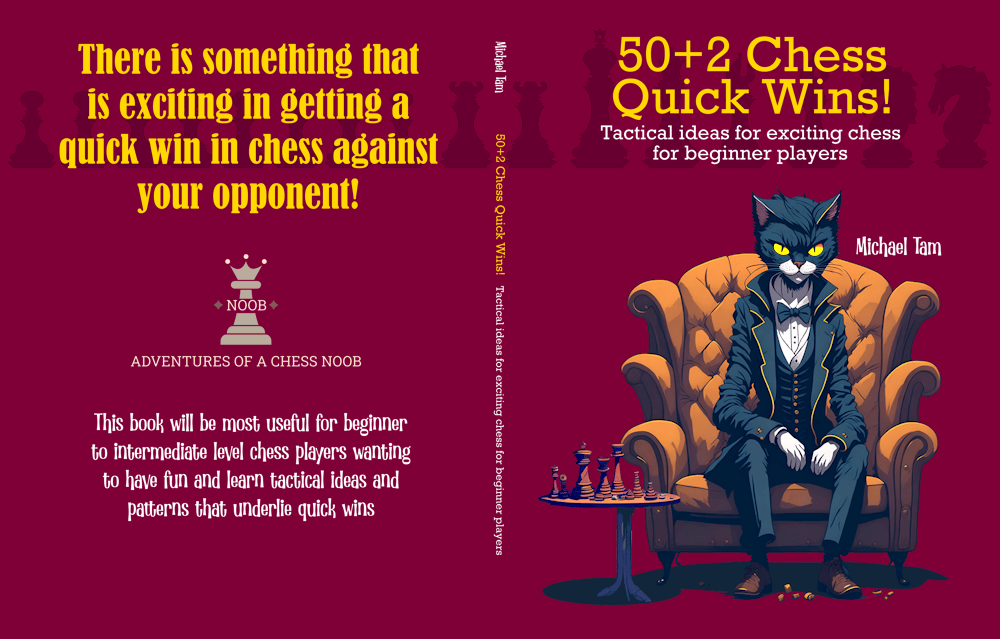
Confidence BOOST at the end of a LOSING STREAK! 😢💤😊
#giraffeattack #fishingpole #tactics
It’s currently school holidays in Sydney and last week, we spent a day in Manly. Mrs Chess Noob, Little Chess Noob and I had a tutorial to learn beach fishing from local fishing guru and YouTuber Alex Bellissimo.

![]()
That evening, I spent some time in the hotel bar playing chess on my Chessnut GO and had a massive losing streak… 🥲 I think it was the combination of having had a beer, a bit distracted from being tired, the dim lighting and the small pieces of the GO, but I played like a complete noob, hanging pieces on diagonals, and more than once mistook bishops for pawns! 😅
The next day, however, I played these two very satisfying games against the same opponent and got a boost back to my confidence! 😊
![]()
Game 1: The Tricky Giraffe in Vienna!
https://www.chess.com/game/live/114495011661
In the first game, I had the white pieces and played the Giraffe Attack in the Vienna Game (1. e4 e5 2. Nc3 Bc5 3. Qg4). My Vietnamese opponent seemed to like the Bishop’s Opening type approach, as well as play aggressive early moves. I respect this, as it often leads to really fun and dynamic games, but it can be risky!

![]()
A historical note:
The Giraffe Attack is a relatively contemporary opening and is arguably a bit unsound. It’s a rare response (ninth most frequent) to the Anderssen Defense to the Vienna Game (1. e4 e5 2. Nc3 Bc5), seen only 1% of the time from the position. However, it’s one of the most winning lines for White, and according to the Lichess community database, White wins 52% to Black 45%. I really enjoy playing the Giraffe Attack because it’s trappy, but also because of its silly name! The move was named by Eric Schiller; he wrote:
The queen should not move to this square [g4] unless it can safely capture at g7, and here she cannot. We might call this the Giraffe Attack, because White is sticking his neck out here.
— Eric Schiller (1998), Unorthodox Chess Openings, p. 458
![]()
Schiller provides evidence of the problem of the Giraffe Attack with one of the earliest games in the databases from 1968, where Giorgi Tsikhelashvili (1948-) attempted to use it against future GM and 12th World Chess Champion, Anatoly Karpov (1951-) in the Soviet Team Championship, and captured the g7-pawn with the queen after (3… Nf6) – a mistake! (Tsikhelashvili — Karpov, 1968, Riga, Latvia)
![]()
In this game, Black played one of the most common responses to the Giraffe Attack, which is (3… Qf6), threatening a Scholar’s Mate type attack with their queen and bishop on the f2 square. However, this is easily neutralised with (4. Nf3). Black now plays a common aggressive move that’s a mistake against the Giraffe – (4… Nh6). There is a direct and intuitive logic to chase the queen, but after (5. Qg3), Black has nothing there, and their knight is now standing awkwardly on the side of the board.
More than that, in the Giraffe Attack 3… Qf6 line, White is always poised to strike with the powerful Nd5, a very thematic tactic in the Vienna Game. Black, unfortunately, doesn’t recognise the threat and the need to defend the d5 square, and instead, plays a developing move (5… d6?). My knight strikes forward (6. Nd5!), threatening Black’s queen on f6, and Black suddenly realises that they are in trouble. Fundamentally, Black cannot defend both their c7- and g7-pawns with a single queen move. After thinking for almost one-and-a-half minutes, Black plays (6… Qe6??), a blunder as (7. Nxc7+), family fork! Emotional damage, GG!
![]()
Game 2: Pins and Fishing Hooks!
https://www.chess.com/game/live/114495033787
My opponent was understandably dissatisfied with the first game so requested a rematch, and I obliged! This time, they had the white pieces and like the first game, started with a Bishop’s Opening. From the first game, I had a sense that they liked playing aggressively, and that seems to be often the case for Bishop’s Opening players!
So, against this I almost always respond with (2… Nc6), which invites White to transpose back to an Italian (their most accurate move), which they did (3. Nf3), and I then played the solid Two Knights Defense (3… Nf6). White blitzed out these moves, so I suspect there were familiar with them, and immediately entered the Open Italian (4. d4), which transposes to the Scotch Gambit, Dubois Réti Defense (4… exd4).
Fortunately, I have some familiarity with this line (it’s the preferred line I play with Black against the Scotch Gambit), and as we didn’t reach the position via the Scotch Game, it’s not uncommon that White will be out of theory. And this was the case with their (5. Nxd4?!), an inaccuracy as (5. e5) is the most forcing move and best for White.
In this position, I usually play (5… Bc5). Stockfish rates this as inaccurate, preferring the more direct (5… Nxe4), capturing White’s e-pawn. However, my perspective is that I didn’t want to open the e-file while White has a potential massive attack of my king. Putting the king’s bishop on c5 puts pressure on White’s weak f2-pawn, and as we shall see, this ended up being the winning tactical resource in the game!
White opted to end their attack by trading away their forward knight (6. Nxc6 bxc6), develop further, and then castled kingside. And I saw my opportunity – (8… Ng4) – I decided to immediately launch an attack and delay castling! White played a slightly slow developing move afterwards, and so I revealed the full threat with (9… Qh4)! Now, I had an immediate checkmate threat with Qxh2 and three attackers on White’s f2-pawn! Moreover, note that after White castled, their f-pawn is now pinned to the king by my dark square c5-bishop!
Evaluation-wise, White is completely fine, but only if they find the only good move – (10. Bf4). This is why one must always take Stockfish evaluation metrics with caution. The evaluation is in the context that both players not only play accurately but have little difficulty in computing the evaluation-metric. From a human perspective, positions where there is only a single good move are difficult as any mistakes made will be more impactful.
White finds the intuitive and second-best move (10. h3?), but the forcing nature of my attack already makes this a mistake! This pawn move substantially weakens the dark squares around White’s king. Moreover, the pawn doesn’t threaten my g4-knight as I have (10… h5!!), a brilliant move, the fishing pole tactic! If White captures the knight with the pawn, then recapturing with hxg4 opens the h-file, revealing a rook-queen battery and an unstoppable mating attack!
White realises this and attempts to bring their dark square bishop into the defence around their king (11. Bf4?). I provoke it by pushing another pawn (11… g5!?) towards White’s king and forcing another bishop move. Under pressure, White blunders [-10]! They played (12. Bg3??), and it seems that they’ve trapped my queen! However, they forgot that their f2-pawn was pinned… (11… Qxg3), I capture the bishop and am threatening checkmate with Qh2, exploiting the weak dark squares. 🤩
In the position, White has only one way of avoiding immediate or near-term checkmate, which is to trade away their queen for my knight. That’s difficult to play, so they accept the fishing pole attack instead (13… hxg4??). I think that they thought that they might have a counterattack with (14. Bxf7+). I thought very carefully – White did have some checks that they could make. Interestingly, Stockfish thinks that checkmate is unavoidable regardless and can only be delayed [-M4] and that I should just capture their bishop with the king. After a minute, I decided to decline their offer with (14… Ke7) and then realised afterwards that (14… Kd8) would have even been better. However, it didn’t matter! White was undoubtedly hoping that I would capture the bishop and then blunder when they gave more checks. By declining, their last hope was dashed, and so resigned with emotional damage. Good game, GG!
I’m not sure there are any big takeaways from these games other than to always be on the lookout for tactics in the opening and early middlegame. Setting up tactical resources and following through with a plan will often result in a win, even if the engine thinks that certain moves are suboptimal.




